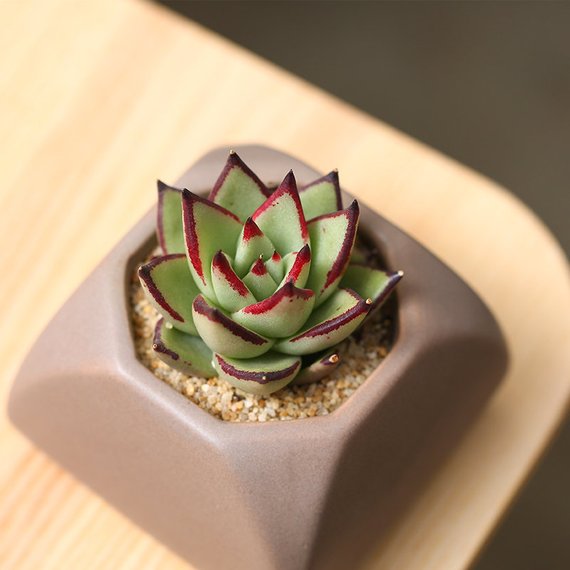Echeveria agavoides 'Ebony', grows rapidly and can easily develop into large plants. While it's not advisable to use large pots for small seedlings, even seedlings should be placed in slightly larger pots to prevent overcrowding. Small pots can cause the crown to grow large, with leaves touching the soil, affecting ventilation and potentially leading to rotting of the basal leaves.
Furthermore, small pots can restrict root growth, resulting in subpar plant development. When selecting pots, it's recommended to choose pots that allow for about 2 to 4 cm of space beyond the leaf tips. For mature plants, pots with a diameter of at least 10 cm are preferable, eliminating the need for frequent repotting due to plant overgrowth.
Soil for Echeveria agavoides 'Ebony' should be well-draining and aerated. Although Echeveria agavoides 'Ebony' may appear robust, improper watering can lead to root rot. Therefore, it's advisable to choose soil with more granules for better drainage. A premium soil mix is recommended for Echeveria agavoides 'Ebony', consisting of materials like rainbow stone, red jade soil, and perlite, with a small addition of high-quality peat soil. This soil provides essential nutrients, retains water well, and ensures proper drainage, making it suitable for Echeveria agavoides 'Ebony' growth.
Echeveria agavoides 'Ebony' thrives in sunlight but may enter dormancy during hot summer periods, so it's essential to avoid intense sunlight exposure. It prefers a sunny environment, and inadequate light can result in elongated growth and greener leaves. While "Red Sleeve" Echeveria agavoides 'Ebony' is typically exposed to sunlight from spring to autumn, shading may be necessary in two situations: firstly, newly potted Echeveria agavoides 'Ebony' should not be exposed to direct sunlight as they haven't yet established root systems to absorb water from the soil, leading to dehydration and shrinking plants; secondly, during the summer, Echeveria agavoides 'Ebony' may enter dormancy, and excessive sunlight can cause leaf sunburn, necessitating appropriate shading.
There's a common misconception among novice growers that longer and more intense sunlight exposure results in darker leaf colors and larger colored areas on Echeveria agavoides 'Ebony' leaves. However, during intense summer sunlight with dry soil, leaf color may darken, but leaves may also become wilted. Therefore, maintaining a suitable growth environment with significant temperature variations between day and night can also yield beautiful results for Echeveria agavoides 'Ebony'. Additionally, the genetic makeup of Echeveria agavoides 'Ebony' plays a significant role in leaf coloration. Most seedlings bred by enthusiasts display deep red leaf edges, which are equally attractive. For those seeking Echeveria agavoides 'Ebony' with black leaf edges, purchasing plants with such features is recommended.
Echeveria agavoides 'Ebony' is drought-tolerant but susceptible to waterlogging, especially during the dormancy period. It's essential to avoid rain during dormancy to prevent damage. Despite its thick leaves indicating drought tolerance, Echeveria agavoides 'Ebony' still requires sufficient watering to prevent leaf wilting and yellowing, especially during the seedling stage when inadequate water can lead to leaf loss.
Fertilization for Echeveria agavoides 'Ebony' should follow a "thin and frequent" approach. Although the soil mix may contain abundant micronutrients, adding a small amount of slow-release fertilizer can enhance soil fertility, especially during the plant's juvenile stage when nutrient needs are higher. When fertilizing, use a diluted fertilizer solution during each watering session to supplement nutrients and promote robust growth.
